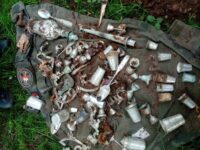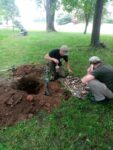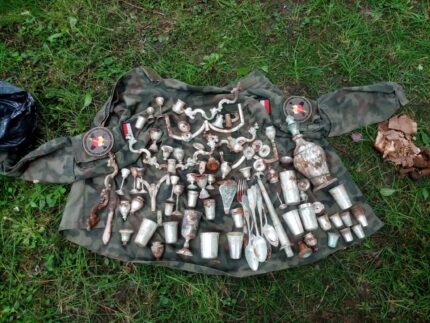 A hoard of silver objects likely buried in World War II has been discovered on the grounds of a 14th century castle in Nowy Sącz, southern Poland. A group from the Nowy Sącz Historical and Exploratory Association were surveying a site near the castle tower when their metal detector alerted them to the presence of what turned out to be a rusted out chest. The crate was corroded almost to nothingness, but the treasure it contained was in excellent condition.
A hoard of silver objects likely buried in World War II has been discovered on the grounds of a 14th century castle in Nowy Sącz, southern Poland. A group from the Nowy Sącz Historical and Exploratory Association were surveying a site near the castle tower when their metal detector alerted them to the presence of what turned out to be a rusted out chest. The crate was corroded almost to nothingness, but the treasure it contained was in excellent condition.
They first unearthed some paperwork — apparently passes and receipts — in poor condition. Under the pages the chest was filled with silver tableware, including goblets, stemware, cups, flatware, serving vessels and candlesticks. In total 103 silver objects were found in the disintegrating chest. The pieces date from the turn of the 19th-20th centuries and the design style identifies them as Jewish ceremonial art.
Local archaeologist Bartłomiej Urbański, who was present at the search site, said: “It is Judaica, probably from the turn of the 19th and 20th century, connected to Jewish ritual and was probably buried during World War Two.
He added: “Is it connected with the buildings that used to be in this part of the city, or was it stolen by the Germans, who were then unable to take it away?”
 The town of Nowy Sącz was founded by Wenceslaus II of Bohemia in 1292, eight years before he became King of Poland. Its location near an important trade route to Hungary garnered it significant privileges. Wenceslaus replaced a wooden watchtower perched on a hill within the city’s fortifications with a castle. In the mid-1300s, King Casimir III the Great greatly expanded the royal castle, integrating it into the new defensive wall he had built around the city. This grander castle of Nowy Sącz had two corner towers, at least one other tower, a residential building with multiple stories, and probably a moat separating it from the city proper. For the next 300 years, Polish kings and queens and visiting Hungarian and Danish royalty stayed in the castle. It was devastated by fire twice, once in 1522, once in 1611. After the second fire, the castle was rebuilt and expanded again in Renaissance style by Count Sebastian Lubomirski and, after his death, by his son Stanisław. That phase ended in 1655 when the castle took heavy damage during the Deluge (Sweden’s invasion of the Polish-Lithuanian Commonwealth). It was patched up a couple of times by Austrian authorities after the Partition, but it never really recovered.
The town of Nowy Sącz was founded by Wenceslaus II of Bohemia in 1292, eight years before he became King of Poland. Its location near an important trade route to Hungary garnered it significant privileges. Wenceslaus replaced a wooden watchtower perched on a hill within the city’s fortifications with a castle. In the mid-1300s, King Casimir III the Great greatly expanded the royal castle, integrating it into the new defensive wall he had built around the city. This grander castle of Nowy Sącz had two corner towers, at least one other tower, a residential building with multiple stories, and probably a moat separating it from the city proper. For the next 300 years, Polish kings and queens and visiting Hungarian and Danish royalty stayed in the castle. It was devastated by fire twice, once in 1522, once in 1611. After the second fire, the castle was rebuilt and expanded again in Renaissance style by Count Sebastian Lubomirski and, after his death, by his son Stanisław. That phase ended in 1655 when the castle took heavy damage during the Deluge (Sweden’s invasion of the Polish-Lithuanian Commonwealth). It was patched up a couple of times by Austrian authorities after the Partition, but it never really recovered.
It was rebuilt again on a much smaller scale in 1938 just in time for the Nazi invasion of Poland. German forces occupied the castle and used it as a barracks. Under German occupation, 20,000 Nowy Sącz Jews were forced into a ghetto. The ghetto was liquidated in 1942 and all of the town’s Jewish community was sent to slaughter in Bełżec extermination camp. German forces stored large quantities of ammunition at the castle and Polish resistance fighters blew up the depot in 1945, destroying what little was left of the castle. The tower was reconstructed one more time in 1959.
After so beleaguered an existence, only a smattering of walls a few feet high remain of the original 14th century structure. The town of Nowy Sącz wants to rebuild the castle (yes, again) and convert the tower into a museum. The Sądecki Regional Development Agency contracted with the Nowy Sącz Historical and Exploratory Association to explore the castle ruins assisted by professional archaeologists. They were scanning for shrapnel and metal parts from the explosion when they discovered the silver cache.
The objects will now be transferred to archaeological conservators who will clean, conserve and catalogue them for future display in the local museum.

In the chaos of the Holocaust in Poland, I suppose it might be very difficult to find who originally owned the magnificent silver or who buried it in the castle grounds. I am assuming the original owners were either a very rich family or an important institution, given that 19th Jewish ceremonial art was beautifully crafted.
I hope the art objects go into the Yad Vashem Art Collection in Jerusalem which is composed of a] early works that commemorate artists and owners murdered in the Holocaust and b] works from the Holocaust period itself.
It does make sense that the papers in the chest would have something to do with who owned it, originally. I hope these papers were salvaged despite their poor condition.
One wonders if it was Nazi loot that was hidden with plans to come back for it later.
i hope that the silvers owner is found and the silver returned to their relatives. Even if the papers were in poor condition research should be done to reunite the familly heirlooms.